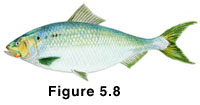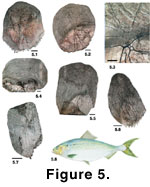 Description
DescriptionAlosa sapidissima (American
Shad)
(Other common names: Atlantic Shad, White Shad, Connecticut River Shad)
Figure 5.8
 Description
DescriptionLength: 76 cm (the largest herring in BC waters).
Mouth: moderately large, terminal, directed slightly upwards; upper jaw extends to the posterior part of orbit; lower jaw notched with a "V-groove" into upper jaw; teeth absent in adults.
Body: coarse downward curving striae on the operculum; strong keels on the large midventral scutes.
Color: dorsal surface is metallic blue shading to white and then silver on the ventral surface; row(s) of four or more spots on side.
Depth: pelagic schooling species.
Habitat: juveniles will school in estuaries and rivers; adults live in marine waters, but their information on their movements is not recorded.
Season: anadromous; timing of spawning in BC waters is not well known but in the southern range there is evidence of almost year-round spawning; spawning takes place in coastal rivers with juveniles moving through the estuaries (generally in the summer months).
Diet: small crustaceans (e.g., copepods, mysids, insect larvae, amphipods) (Morrow, 1980).
Predators: other bony fish (Stevens, 1966), marine mammals (Scott and Crossman, 1973).
Distribution: native to the Atlantic region, include streams and inlets and was introduced in the 1870s to the Sacramento River, California; by 1891 it had reached British Columbia and Alaska by 1904; now common along the entire North American west coast.
 Scale
Description
Scale
DescriptionRelative Size of Scale: large (with adults, larger than Clupea harengus).
Position of Scales on Body: 60 rows in the midline region of the body; midventral line with heavy keeled scutes; scales above and below the midside of the tail fin (Hart, 1973).
Overall Scale Shape: circular to oval. The overall shape of the posterior field is highly variable depending on the scale type. The posterior field tends to be broad at the point of attachment and is gently convex. The outside edge of the posterior field is crentulated. The posterior field is clear with cracks and striations that run in the anterior/posterior axis. The outside edges of the scales are smooth but can be irregularly shaped.
Focus and Circuli: the focus varies from indistinct to very distinct. It is often situated just above the posterior field interface and is generally central between the lateral fields, although it is sometimes slightly offset. The circuli are straight to curved, but generally concentric with the outline of the scale. The circuli are variable within a single scale: some are continuous between fields, others are discontinuous. The circuli tend to be less compacted than in Sardinops, but this is feature is plastic. In regenerated scales the circuli are quite distorted. The circuli are often broken along the midvertical axis of the scale, showing a reticulated pattern. Circuli do not proceed into the posterior field, although some minor reticulation of the circuli may be present just below the attachment interface.
Radii: there are no radii present, however, there are often groove and fracture lines in the scales that can run traversely across the scale, often crossing circuli. These fracture lines are also somewhat irregular.
Remarks: the scales of this species are extremely similar to Clupea harengus